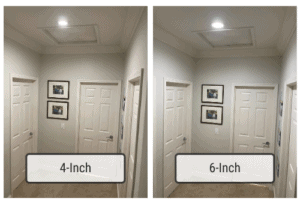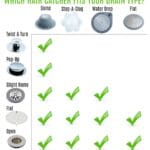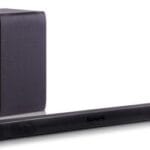Choosing the right lighting for your home or workspace can feel overwhelming, especially when it comes to deciding between 4 inch and 6 inch recessed lighting. You might be wondering which option best suits your needs and aesthetic preferences.
This decision impacts not just the look of your space, but also its functionality and energy efficiency. Imagine transforming your room into a haven of comfort and style, simply by making the right lighting choice. By the end of this article, you’ll have a clear understanding of the advantages and disadvantages of both sizes, empowering you to make an informed decision that enhances your environment.
Dive in, and discover how the right lighting can brighten your world in more ways than one.
Lighting Size Comparison
Choosing between 4-inch and 6-inch recessed lighting depends on your space. Smaller fixtures fit snugly in tight areas, offering focused light. Larger options provide broader illumination, ideal for open spaces. Both sizes enhance room aesthetics, but consider ceiling height and room purpose for the best fit.
Choosing between 4-inch and 6-inch recessed lighting can significantly impact the ambiance and functionality of your space. The size of your lighting fixtures will influence both the aesthetic and the amount of light that fills your room. Understanding the differences can help you make the best decision for your needs. Let’s dive into the details of these two popular options.Dimensions And Specifications
When you think about dimensions, imagine the physical space these lights will occupy. A 4-inch recessed light typically has a smaller trim diameter. This makes it ideal for spaces where you want a more subtle lighting effect. On the other hand, the 6-inch recessed lighting has a larger trim, which can provide broader light coverage. The increased size means it can house bigger bulbs, which can be useful for areas requiring more illumination. The choice between the two often boils down to how much light you need versus how discreet you want your lighting fixtures to be.Common Applications
So where should you use each size? Picture your kitchen or living room. These are areas where 6-inch recessed lights shine—literally. Their broader light spread is perfect for illuminating large spaces. They can efficiently light up work areas like counters and tables, ensuring you have enough light to see what you’re doing. Conversely, 4-inch lights work wonders in places like hallways or small bedrooms. They offer a more focused light, which is excellent for accent lighting. Imagine highlighting a piece of art or creating a cozy reading nook. Have you ever tried to read under harsh overhead lighting? It can be unpleasant. The softer glow of 4-inch lights can create a more inviting atmosphere. Choosing the right size isn’t just about looks—it’s about how you want to feel in your space. What mood do you want to set? Consider the function of each room and let that guide your decision. Ultimately, understanding the differences in size and application can transform your home into a well-lit haven that meets all your needs.
Credit: lusalighting.com
Illumination And Ambiance
Choosing between 4-inch and 6-inch recessed lighting affects your room’s feel. Both sizes offer unique lighting experiences. Your choice impacts brightness and atmosphere. Understanding these differences helps create your desired ambiance.
Brightness Levels
4-inch lights often provide focused illumination. They are ideal for task lighting. These lights can highlight specific areas. This might include kitchen counters or reading nooks.
6-inch lights cover larger areas with ease. They offer widespread light, suitable for general illumination. This size works well in living rooms or larger spaces. It brightens up the area, creating a more open feel.
Light Distribution
4-inch recessed lights offer precise light direction. Their smaller size focuses on targeted spots. This makes them perfect for accent lighting. You can highlight art or architectural details.
6-inch lights have a broader beam spread. They distribute light more evenly across the space. This size is great for filling a room with light. It ensures no corner is left in shadow.
Aesthetic Considerations
Recessed lighting offers a sleek and modern look. Choosing the right size impacts your room’s aesthetics. The choice between 4-inch and 6-inch lights affects design harmony.
Smaller lights provide a subtle appearance. Larger lights make a bold statement. Each size has unique design benefits.
Design And Style
4-inch recessed lights blend seamlessly with ceilings. They offer a refined and elegant style. Their compact design suits minimalist interiors.
6-inch lights stand out more. They add drama to your decor. Their larger size makes a room feel fuller. Perfect for spaces needing more light.
Consider your room’s theme. Match the light size to your design preference. Balance is key in achieving desired aesthetics.
Room Compatibility
Room size influences light choice. Small rooms benefit from 4-inch lights. They create a cozy ambiance without overwhelming the space.
Larger rooms pair well with 6-inch lights. They provide ample illumination. This prevents dark corners and enhances visibility.
Ceiling height is crucial. Higher ceilings need bigger lights. Lower ceilings suit smaller fixtures. Choose lights that complement your room dimensions.

Credit: blog.recessedlighting.com
Installation Factors
Choosing between 4-inch and 6-inch recessed lighting impacts installation. Smaller fixtures fit tighter spaces, while larger ones offer broader illumination. Consider ceiling depth and spacing for optimal light distribution.
When considering recessed lighting, installation factors play a crucial role in deciding between 4-inch and 6-inch fixtures. These factors can influence the ease of installation, ceiling space requirements, and ultimately, the overall look and feel of your space. Understanding these aspects can help you make an informed choice that fits your unique needs and preferences.Ease Of Installation
Installing recessed lighting can be a breeze or a hassle, depending on your choice between 4-inch and 6-inch fixtures. Smaller 4-inch lights are generally easier to handle. Their compact size allows for a straightforward installation process, especially in tight or awkward spaces. However, if you’re installing multiple lights, the larger 6-inch fixtures might be more convenient. They cover more area, potentially reducing the number of fixtures needed. Keep in mind, though, that handling larger fixtures can require more effort, especially if you’re working alone. You might want to ask yourself: do you prefer a simpler installation with smaller lights, or are you willing to manage the larger fixtures for broader coverage?Ceiling Space Requirements
Consider your ceiling space before choosing the size of your recessed lighting. Smaller 4-inch lights are ideal for spaces with limited ceiling depth. They are less intrusive and can blend seamlessly into lower ceilings. On the other hand, 6-inch lights often require more space. If you have a high ceiling or plenty of room above, these larger fixtures can be a perfect fit. They tend to make a bold statement and provide more light output. Imagine standing in your room and visualizing how each size might look. Which option aligns better with your ceiling height and room dimensions? Ultimately, your choice should reflect not just practical concerns but also your personal taste. Whether you opt for 4-inch or 6-inch recessed lighting, focus on creating a space that feels right for you.Energy Efficiency
Energy efficiency plays a crucial role in choosing recessed lighting. It impacts not only your electricity bill but also the environment. Both 4-inch and 6-inch recessed lights offer distinct advantages in energy usage. Understanding their efficiency can guide your decision.
Wattage And Power Consumption
4-inch recessed lights typically consume less power. They generally use bulbs with lower wattage. This means reduced electricity usage. In contrast, 6-inch lights may use higher wattage bulbs. Their larger size can demand more power. Yet, they often provide brighter illumination. Selecting the right size depends on your lighting needs and energy goals.
Long-term Savings
Choosing the right size can lead to substantial savings over time. Smaller 4-inch lights can lower your energy bills. They consume less electricity. This makes them ideal for long-term cost efficiency. On the other hand, 6-inch lights, though using more power, can reduce the number of fixtures needed. Fewer fixtures mean less installation cost. Consider your space and budget for optimal savings.

Credit: sonicelectric.com
Cost Analysis
Choosing between 4-inch and 6-inch recessed lighting impacts cost and style. Smaller lights often cost less and offer a sleek look. Larger options might brighten spaces better but can be pricier.
When choosing between 4-inch and 6-inch recessed lighting, understanding the cost implications can guide you in making an informed decision. Lighting choices impact not just your wallet but also the ambiance of your space. A closer look at the initial investment, maintenance, and replacement costs can help you determine the best fit for your budget and needs.Initial Investment
The initial cost of recessed lighting varies significantly between 4-inch and 6-inch options. Generally, 6-inch fixtures tend to be slightly cheaper than their 4-inch counterparts. This is because 6-inch lights are more common and thus benefit from economies of scale. If you’re outfitting a larger area, the difference in price can add up quickly. Consider your room size and how many fixtures you’ll need. Would a higher upfront cost for 4-inch lights be worth the potential aesthetic benefits?Maintenance And Replacement Costs
Maintenance and replacement costs are crucial in the long-term budget for recessed lighting. Smaller 4-inch lights often come with energy-efficient LED options, reducing your electricity bills over time. They might also last longer, meaning fewer replacements and lower maintenance costs. While 6-inch lights might require more frequent bulb changes, the bulbs themselves are generally less expensive. This can be a deciding factor if you prefer minimal upfront costs and are okay with periodic replacements. Think about your long-term plans for the space. Do you value convenience and lower long-term costs, or is the initial price your primary concern? Your choice will impact your ongoing expenses and effort in maintaining your lighting.Making The Right Choice
Choosing between 4-inch and 6-inch recessed lighting can be challenging. Each size has its benefits, and the right choice depends on your specific needs. This guide will help you decide which option suits your space best.
Assessing Your Needs
Consider the purpose of the room. A living room may need more ambient light, while a study requires focused lighting. Think about ceiling height. Taller ceilings might benefit from larger fixtures. Examine the room’s design and color scheme. Darker colors absorb more light, needing brighter illumination. The intended mood plays a role too. Cozy, warm spaces may need softer, smaller lights.
Expert Recommendations
Experts often suggest 4-inch lights for task lighting. They provide focused, direct light. Ideal for kitchens or workspaces. For general lighting, 6-inch fixtures are preferred. They offer wider light spread. Perfect for living rooms or open areas. Consult with a lighting professional. They provide tailored advice based on your space. Their insights can guide your final decision.
Frequently Asked Questions
What Is The Difference Between 4-inch And 6-inch Recessed Lights?
4-inch lights are smaller, more subtle. Great for focused lighting. 6-inch lights provide broader light, better for general areas.
Which Recessed Lighting Size Is Better For Small Rooms?
4-inch recessed lights are ideal for small rooms. They save space and offer concentrated light on specific spots.
Are 6-inch Recessed Lights Suitable For High Ceilings?
Yes, 6-inch lights work well for high ceilings. They offer wide illumination, reducing dark spots in bigger areas.
How Does Recessed Light Size Affect Room Aesthetics?
Light size impacts room look. Smaller lights blend in, while larger lights stand out more, affecting room style.
Do 4-inch Lights Consume Less Energy Than 6-inch?
Not necessarily. Energy use depends on bulb type, not light size. LED bulbs save energy in both sizes.
Conclusion
Choosing between 4-inch and 6-inch recessed lighting depends on your needs. Smaller spaces benefit from 4-inch lights. They create a cozy feel. Larger rooms often need 6-inch lights. They provide more illumination. Consider your room’s size and purpose. Think about the mood you want.
Both sizes offer unique benefits. Energy efficiency and design matter too. Choose wisely for the best effect. Lighting impacts room ambiance significantly. Consult a lighting expert if unsure. They can offer valuable advice. Make your home inviting and well-lit.




